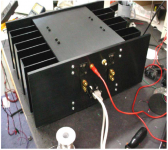Blonde Hedgehog
My blonde has 7cm hair length.
It is quite extra long, textbook formula would shave her all up.
A comparison test with a near similar size heatsink (210 pins 30x3x3 mm on 125x50 aluminium substrate spreader) shown a respectable gain of her.
Pascal
My blonde has 7cm hair length.
It is quite extra long, textbook formula would shave her all up.
A comparison test with a near similar size heatsink (210 pins 30x3x3 mm on 125x50 aluminium substrate spreader) shown a respectable gain of her.
Pascal
Attachments
-
 F2ED5E83-19E1-4FDF-8C2C-AB06A63495AB.jpeg81.7 KB · Views: 521
F2ED5E83-19E1-4FDF-8C2C-AB06A63495AB.jpeg81.7 KB · Views: 521 -
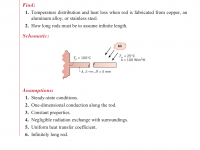 7FA0B515-C9EA-4118-A0D1-2182AAE194E6.png354.8 KB · Views: 483
7FA0B515-C9EA-4118-A0D1-2182AAE194E6.png354.8 KB · Views: 483 -
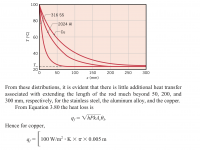 0C296AB0-56A4-4E9E-B23B-25DBC306ECA4.png213.4 KB · Views: 502
0C296AB0-56A4-4E9E-B23B-25DBC306ECA4.png213.4 KB · Views: 502 -
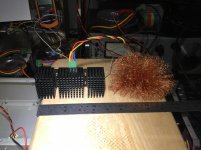 3A9FA5FB-4422-4AC2-B627-EBBA6CA59F54.jpg732.2 KB · Views: 496
3A9FA5FB-4422-4AC2-B627-EBBA6CA59F54.jpg732.2 KB · Views: 496 -
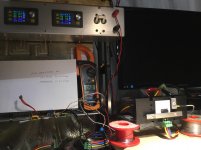 BD03B1C7-8B9A-4B5D-B9FA-B86A95F48992.jpg707.8 KB · Views: 489
BD03B1C7-8B9A-4B5D-B9FA-B86A95F48992.jpg707.8 KB · Views: 489
My blonde has 7cm hair length.
It is quite extra long, textbook formula would shave her all up.
A comparison test with a near similar size heatsink (210 pins 30x3x3 mm on 125x50 aluminium substrate spreader) shown a respectable gain of her.
Pascal
Resurrecting this old one; that is an excerpt from Fundamentals of Heat and Mass Transfer, Incropera, Dewitt right? It brought back my memories from the Undergrad times
I cant help thinking that some suitable array of vertical copper pipe might work well IF one could get the heat into them. Machining a copper saddle that could be soldered on and use to mount a big device would be tricky. But I rather like the steampunk look.
Failing that some thick wall square/rectangular section ally tube is easy to mount to, relatively easy to find and can be welded...
there is an old post on `chimney effect' somewhere...
Failing that some thick wall square/rectangular section ally tube is easy to mount to, relatively easy to find and can be welded...
there is an old post on `chimney effect' somewhere...
BIG solid chunk of aluminium
Hi All,
First Post here. Just collecting bits for an LM3886T Amp. I intend trying a 1/2" X 3" X 10 " chunk of plain aluminium bolted to a 1/8 thick aluminium chassis. It will be insulated by a single layer of Kapton tape and insulated washers and tubes or o rings for the bolts .
I know fins increase the surface area but the chassis should have plenty of that. Only question for me is the heat transfer through the kapton tape but I think the sheer size should do the trick anyway. at least the uninsulated chip should well coupled to the heat sink.
If it gets too hot I will bolt a few fins to it, or another chunk of Ally. I could get fancy and cut slots or drill vertical holes but more bulk will be easier IMO. I quite like the idea of vertical holes acting as chimneys as well as increasing surface area, but find drilling holes 'Boring'.
It will be running on about +_ 20v DC into 4 ohms
Will let you know how it goes. Has anyone else tried such a crude approach?
Hi All,
First Post here. Just collecting bits for an LM3886T Amp. I intend trying a 1/2" X 3" X 10 " chunk of plain aluminium bolted to a 1/8 thick aluminium chassis. It will be insulated by a single layer of Kapton tape and insulated washers and tubes or o rings for the bolts .
I know fins increase the surface area but the chassis should have plenty of that. Only question for me is the heat transfer through the kapton tape but I think the sheer size should do the trick anyway. at least the uninsulated chip should well coupled to the heat sink.
If it gets too hot I will bolt a few fins to it, or another chunk of Ally. I could get fancy and cut slots or drill vertical holes but more bulk will be easier IMO. I quite like the idea of vertical holes acting as chimneys as well as increasing surface area, but find drilling holes 'Boring'.
It will be running on about +_ 20v DC into 4 ohms
Will let you know how it goes. Has anyone else tried such a crude approach?
Shiny metal has poor emissivity (circa 0.2) and thus not a good infrared radiator but the dominant heat transfer mode in ambient air 55C heatsinks is natural or forced convection and the emissivity is not important in that mode. Surface area, intrinsic thermal conductivity, size and spacing of fin orientation are dominant factors. Fin spacing can be made smaller to increase surface area for same volume but that is hard for natural convection so fans can be used. Making fin spacing smaller and fins thinner results in a high thermal density lower cost cooling solution when used with fans, e.g., CPU coolers. Bulk metal by the pound is much more expensive than thin fins and a fan.
In a vacuum (like outer space), radiative loss is the only means of heat transfer, and here, emissivity is increased not with anodization, but by covering the surface with silver coated (on the backside) transparent Teflon tape. Teflon has high emissivity and the silver inner surface reflects thermal radiation from the outside like a second surface mirror, and so acts like a radiative heat transfer diode.
In a vacuum (like outer space), radiative loss is the only means of heat transfer, and here, emissivity is increased not with anodization, but by covering the surface with silver coated (on the backside) transparent Teflon tape. Teflon has high emissivity and the silver inner surface reflects thermal radiation from the outside like a second surface mirror, and so acts like a radiative heat transfer diode.
Last edited:
1)use grease between chipamp and solid bar and between bar and chassis.LM3886T Amp. I intend trying a 1/2" X 3" X 10 " chunk of plain aluminium bolted to a 1/8 thick aluminium chassis. It will be insulated by a single layer of Kapton tape and insulated washers and tubes or o rings for the bolts . ....... Has anyone else tried such a crude approach?
2)Fender does, in 100W Guitar amps.

4 TO247 power transistors mounted on a 30mm wide by 12mm thick by 200mm long solid aluminum bar, which is boltd to 1/16" thick aluminum chassis.
They are successfully dissipating way more power than you.
Last edited:
- Home
- Amplifiers
- Pass Labs
- DIY heatsink
